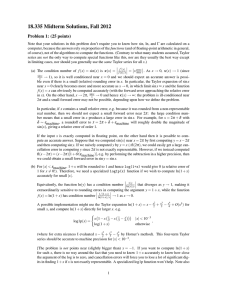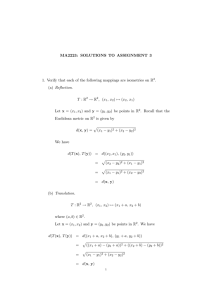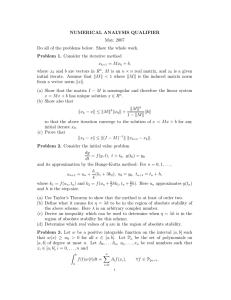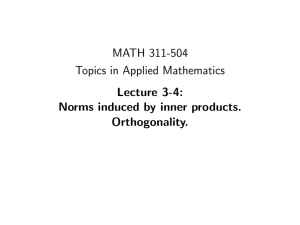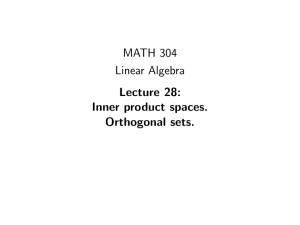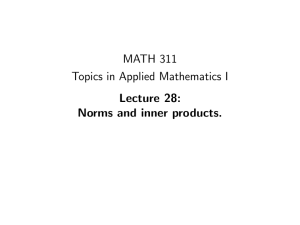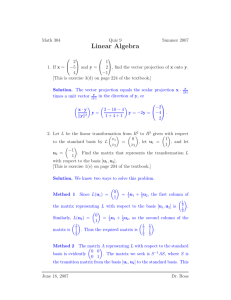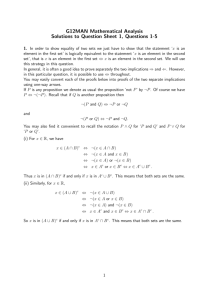ON THE TRIANGLE INEQUALITY IN QUASI-BANACH SPACES JJ II
advertisement
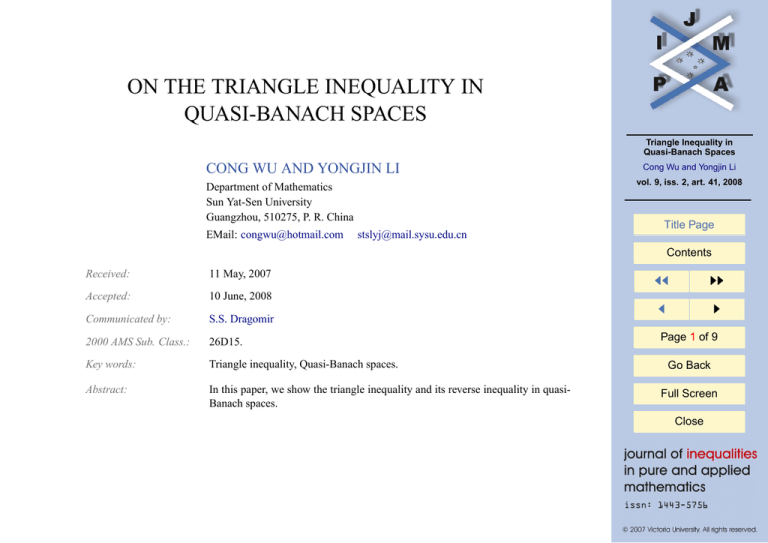
ON THE TRIANGLE INEQUALITY IN
QUASI-BANACH SPACES
Triangle Inequality in
Quasi-Banach Spaces
CONG WU AND YONGJIN LI
Department of Mathematics
Sun Yat-Sen University
Guangzhou, 510275, P. R. China
EMail: congwu@hotmail.com
Cong Wu and Yongjin Li
vol. 9, iss. 2, art. 41, 2008
Title Page
stslyj@mail.sysu.edu.cn
Contents
Received:
11 May, 2007
Accepted:
10 June, 2008
Communicated by:
S.S. Dragomir
2000 AMS Sub. Class.:
26D15.
Key words:
Triangle inequality, Quasi-Banach spaces.
Abstract:
In this paper, we show the triangle inequality and its reverse inequality in quasiBanach spaces.
JJ
II
J
I
Page 1 of 9
Go Back
Full Screen
Close
Contents
1
Introduction
3
2
Main Results
4
Triangle Inequality in
Quasi-Banach Spaces
Cong Wu and Yongjin Li
vol. 9, iss. 2, art. 41, 2008
Title Page
Contents
JJ
II
J
I
Page 2 of 9
Go Back
Full Screen
Close
1.
Introduction
The triangle inequality is one of the most fundamental inequalities in analysis. The
following sharp triangle inequality was given earlier in H. Hudzik and T. R. Landes
[2] and also found in a recent paper of L. Maligranda [5].
Theorem 1.1. For all nonzero elements x, y in a normed linear space X with kxk ≥
kyk,
x
y kyk
kx + yk+ 2 − +
kxk kyk ≤ kxk + kyk
x
y
≤ kx + yk + 2 − +
kxk kyk kxk.
We recall that a quasi-norm k · k defined on a vector space X (over a real or
complex field K) is a map X → R+ such that:
(i) kxk > 0 for x 6= 0;
(ii) kαxk = |α|kxk for α ∈ K, x ∈ X;
(iii) kx + yk ≤ C(kxk + kyk) for all x, y ∈ X, where C is a constant independent
of x, y.
If k · k is a quasi-norm on X defining a complete metrizable topology, then X is
called a quasi-Banach space.
In the present paper we will present the triangle inequality in quasi-normed spaces.
Triangle Inequality in
Quasi-Banach Spaces
Cong Wu and Yongjin Li
vol. 9, iss. 2, art. 41, 2008
Title Page
Contents
JJ
II
J
I
Page 3 of 9
Go Back
Full Screen
Close
2.
Main Results
Theorem 2.1. For all nonzero elements x, y in a quasi-Banach space X with kxk ≥
kyk
x
y
kx + yk+C 2 − +
kxk kyk kyk
(2.1)
≤ C(kxk + kyk)
x
y 2
kxk,
(2.2)
≤ kx + yk + 2C − +
kxk kyk where C ≥ 1.
Proof. Let kxk ≥ kyk. We first show the inequality (2.1).
x
y
x
x kx + yk = kyk
+
+ kxk
− kyk
kxk kyk
kxk
kxk x
y
x
x
≤C
kyk kxk + kyk + C kxk kxk − kyk kxk x
y
= Ckyk kxk + kyk + C(kxk − kyk)
x
y
+
= Ckyk kxk kyk + C(kxk + kyk − 2kyk)
x
y
+
− 2 + C(kxk + kyk).
= Ckyk kxk kyk Triangle Inequality in
Quasi-Banach Spaces
Cong Wu and Yongjin Li
vol. 9, iss. 2, art. 41, 2008
Title Page
Contents
JJ
II
J
I
Page 4 of 9
Go Back
Full Screen
Close
Since
x
y
y
y kx + yk = kxk
+
− kxk
− kyk
kxk kyk
kyk
kyk x
1 y x
x ≥ kxk
+
− kxk
− kyk
C
kxk kyk kxk
kxk x
1
y − (kxk − kyk)
= kxk +
C
kxk kyk x
1
y + (kxk + kyk − 2kxk)
= kxk +
C
kxk kyk x
y
1 − 2 + (kxk + kyk).
= kxk
+
C kxk kyk Triangle Inequality in
Quasi-Banach Spaces
Cong Wu and Yongjin Li
vol. 9, iss. 2, art. 41, 2008
Title Page
Contents
we have
x
y kxk
C(kxk + kyk) ≤ Ckx + yk + 2C − +
kxk kyk x
y
= kx + yk + (C − 1)kx + yk + 2C − kxk + kyk kxk
x
y
≤ kx + yk + (C − 1)C(kxk + kyk) + 2C − kxk + kyk kxk
x
y
≤ kx + yk + (C − 1)C(2kxk) + 2C − +
kxk kyk kxk
x
y
+
= kx + yk + 2C 2 − kxk kyk kxk.
Thus the inequality (2.2) holds.
JJ
II
J
I
Page 5 of 9
Go Back
Full Screen
Close
T. Aoki [1] and S. Rolewicz [6] characterized quasi-Banach spaces as follows:
Theorem 2.2 (Aoki-Rolewicz Theorem). Let X be a quasi-Banach space. Then
there exists 0 < p ≤ 1 and an equivalent quasi-norm k| · k| on X that satisfies for
every x, y ∈ X
k|x + yk|p ≤ k|xk|p + k|yk|p .
Idea of the proof. Let k · k be the original quasi-norm on X, denote by k = inf{K ≥
1 : for any x, y ∈ X, kx + yk ≤ K(kxk + kyk)} and p is such that 21/p = 2k. It is
shown [3] that the function k| · k| defined on X by:
! p1
n
n
X
X
p
:x=
xi
k|xk| = inf
kxi k
i=1
Triangle Inequality in
Quasi-Banach Spaces
Cong Wu and Yongjin Li
vol. 9, iss. 2, art. 41, 2008
Title Page
i=1
Contents
is an equivalent quasi-norm on X that satisfies the required inequality.
Next, we will prove the p-triangle inequality in quasi-Banach spaces.
Theorem 2.3. For all nonzero elements x, y in a quasi-Banach space X with kxk ≥
kyk,
p y p
p
p
p
p x
+
kx + yk + kxk + kyk − (kxk − kyk) − kyk kxk kyk ≤ kxkp + kykp
p y p
p
p
p
p x
,
≤ kx + yk + kxk + kyk + (kxk − kyk) − kxk +
kxk kyk where 0 < p ≤ 1.
JJ
II
J
I
Page 6 of 9
Go Back
Full Screen
Close
Proof. We have
p
y
x
x
x
kx + yk = +
−
kyk
kyk
+
kxk
kxk kyk
kxk
kxk p
p x
y
x
x
+ kxk
≤
kyk
+
−
kyk
kxk kyk kxk
kxk p
y p x
+ (kxk − kyk)p
= kyk +
kxk kyk p
y p x
+ kxkp
= kyk +
kxk kyk + kykp − (kxkp + kykp ) + (kxk − kyk)p .
p
Triangle Inequality in
Quasi-Banach Spaces
Cong Wu and Yongjin Li
vol. 9, iss. 2, art. 41, 2008
Title Page
Thus
Contents
p y p
p
p
p
p x
≤ kxkp + kykp
kx + yk + kxk + kyk − (kxk − kyk) − kyk +
kxk kyk JJ
II
and
J
I
p
x
y
y
y
p
kx + yk = kxk kxk + kyk − kxk kyk − kyk kyk p
p x
y
x
x
− kxk
≥
kxk
+
−
kyk
kxk kyk kxk
kxk p
x
y
p
+
= kxkp kxk kyk − (kxk − kyk)
p
y p x
= kxk +
kxk kyk + kxkp + kykp − (kxkp + kykp ) − (kxk − kyk)p .
Page 7 of 9
Go Back
Full Screen
Close
Hence
p x
y
+
kxkp +kykp ≤ kx+ykp + kxkp + kykp + (kxk − kyk)p − kxkp kxk kyk .
This completes the proof.
Triangle Inequality in
Quasi-Banach Spaces
Cong Wu and Yongjin Li
vol. 9, iss. 2, art. 41, 2008
Title Page
Contents
JJ
II
J
I
Page 8 of 9
Go Back
Full Screen
Close
References
[1] T. AOKI, Locally bounded linear topological spaces, Proc. Imp. Acad. Tokyo, 18
(1942), 588–594.
[2] H. HUDZIK AND T.R. LANDES, Characteristic of convexity of Köthe function
spaces, Math. Ann., 294 (1992), 117–124.
[3] N.J. KALTON, N.T. PECK AND J.W. ROBERTS, An F-Space Sampler, London
Math. Soc. Lecture Notes 89, Cambridge University Press, Cambridge, 1984.
Triangle Inequality in
Quasi-Banach Spaces
Cong Wu and Yongjin Li
vol. 9, iss. 2, art. 41, 2008
[4] K.-I. MITANI, K.-S. SAITO, M.I. KATO AND T. TAMURA, On sharp triangle
inequalities in Banach spaces, J. Math. Anal. Appl., 336 (2007), 1178–1186.
Title Page
[5] L. MALIGRANDA, Simple norm inequalities, Amer. Math. Monthly, 113
(2006), 256–260.
[6] S. ROLEWICZ, On a certain class of linear metric spaces, Bull. Acad. Polon.
Sci. Sér. Sci. Math. Astrono. Phys., 5 (1957), 471–473.
Contents
JJ
II
J
I
Page 9 of 9
Go Back
Full Screen
Close

